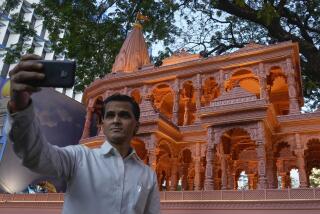In India, Pope to Find Land of Countless Faiths : 10-Day Trip Will Cover Length of Subcontinent; Hindus Plan Protests
- Share via
NEW DELHI — When Bombay architect Charles Correa designed the modern Roman Catholic church in his home city a few years ago, he said he tried to capture the grandeur of the heavens with a simple, unadorned statement.
He chose for the main altar a magnificent slab of rough-hewn granite, illuminated by crossing shafts of sunlight from skylights.
However, parishioners at the Salvacao Church, a central place of worship for Bombay’s 500,000 Catholics--many of them, like Correa, immigrants from the former Portuguese colony of Goa--avoided the main altar. They complained to priests that they had come to worship God and the Virgin Mary, not a piece of rock.
Small Chapel Set Up
As a compromise, Correa set up a small chapel to the side of the main church, with an ornate candle-lit altar, burning incense and realistic, fully clothed dolls representing Jesus Christ and the Holy Mother. It soon became more crowded than the larger main church.
Even non-Christians, including Hindus from surrounding neighborhoods, began to visit the side altar. They left traditional offerings, or puja gifts--pieces of molded butter, flower petals and colored grains of rice--to the statues. In fact, the gaily dressed figurines did resemble models of Hindu gods. With a little imagination, they could be seen as Lakshmi, goddess of fortune, or Krishna, the beloved incarnation of the god Vishnu.
“There is a strong influence from Hinduism on the church in India,” said Father Edward R. Hambye, a Belgian Jesuit priest and church historian who has lived in India for 35 years. “There is a definite inclination to Hindu devotion piety--what they call bhakti.”
Such is the hybrid Christianity that Pope John Paul II will find when he begins his first visit to India on Saturday. His 10-day journey will take him the length of the subcontinent, from the cool, misty tribal areas of northeast India, once a haven for headhunters, to the steamy south, where Christianity dates from the 1st Century and the Apostle Thomas.
Land of Religious Diversity
India is often depicted as a land of religious diversity and tolerance. Two of the world’s great religions, Buddhism and Hinduism, were founded here. For several centuries, India was an independent Islamic empire. Even today, there are more Muslims here than in any other country except Indonesia.
Countless other sects, faiths and cults exist here: fire-worshiping Zoroastrians; gentle Jains who practice nonviolence, or ahimsa, toward all living things; the martial, always armed, Sikhs of Sikhism; tribal animists. . . .
There are also, astonishingly, 22 million Christians, including the 12 million Catholics whom the Pope is coming to see. That is about 3% of India’s masses, with the Catholics forming 1.6% of the total.
Despite this seeming diversity, however, and a disproportionate Christian influence on education and health services, the central element of Indian society is its nearly 500 million Hindus. There are as many Hindus in India as there are Catholics in all of South America and Europe.
An Inexorable Force
Hinduism, a faith of many gods that is maintained through a rigid caste system, controls the social order here. Historically, it has been an inexorable force, a massive, glacial power that has swallowed up other religions flowering in its path.
In contrast, Buddhism, which began here and was the faith of the Mauryan emperor Asoka (273-232 BC), is no longer practiced here except in regions of the Himalayas influenced by the Tibetan culture.
In recent decades, the power of Hinduism in India has been bolstered by the emerging Hindu fundamentalist movement embodied in two main groups, the Vishwa Hindu Parishad, or World Hindu Council, and the Rashtriya Swayam Sevak, or National Volunteers. The fundamentalist movement has made Hinduism a jealous, protective faith and taken the shine off India’s reputation for religious tolerance.
“One of the fascinating aspects of India was the lack of religious xenophobia that existed,” said Father Hambye, the historian. “Now this Hindu fundamentalist movement has changed things.”
Assassination of Gandhi
Mohandas K. Gandhi, the nonviolence-preaching hero of India’s independence movement, was assassinated in New Delhi in 1947 by a Hindu fundamentalist who objected to Gandhi’s ecumenism. Lately, the fundamentalists have launched campaigns in several states to expel foreign missionaries. Recently, 10 Catholic missionaries were expelled from the central state of Madhya Pradesh.
The fundamentalist groups have organized protests against the Pope’s visit. A Hindu rally against the papal visit is planned for New Delhi tonight, the eve of his arrival. Organizers say they will use it to push for a national law prohibiting religious conversions.
As a result of the hostile atmosphere among the Hindu fundamentalists, the Vatican has decided to stress religious ecumenism on the current visit. As he did in Africa on his visit last August, the Pope plans to confer with local leaders of different faiths. Church leaders in India are doing their best to allay fears that he is coming on a mission to convert Hindus to Christianity, even going so far as to contend that conversion is no longer a mission of the Catholic Church.
Air of a State Visit
The Vatican appears particularly sensitive to charges by the Hindu extremists that the pontiff’s trip is an official state visit in his capacity as head of state of Vatican City. In fact, the journey does have the air of a state visit, since the Pope was invited by India’s President Zail Singh and will be transported in Prime Minister Rajiv Gandhi’s Indian air force plane, as well as Indian air force helicopters.
However, his itinerary is decidedly religious.
With the exception of New Delhi, where he will meet with Gandhi and celebrate Mass in Indira Gandhi Stadium, all the 14 places he will visit have sizable Catholic populations.
After two days in the capital, John Paul will travel to Ranchi in the impoverished eastern state of Bihar. Ranchi is home to more than half a million Indian untouchables, tribal people who fall outside even the lowest levels of the Hindu caste system. They were converted to Catholicism in the mid-19th Century.
Organizing Hindu Serfs
Significantly, the Pope will not visit the northern Bihar Muzafapur area, where radical Catholic priests have recently organized Hindu serfs against powerful landlords, some of whom even maintain their own armies for private wars against their foes and bands of roving bandits, or dacoits .
Similarly, when he visits the Catholic stronghold state of Kerala in southern India, he has no plans to visit areas in which radical priests and nuns, India’s version of South America’s “liberation theologists,” have organized sailboat fishermen, mostly Hindus and Muslims, against the motorized fishing trawler industry. Clearly, the papal visit will not invite a confrontation over liberation theology, a movement the Pope strongly opposes.
After Bihar, he will make a dramatic visit to Calcutta, where he will meet with Mother Teresa, a Catholic nun and Nobel Peace laureate, at her mission in that city.
From Bengal he will make a short, and almost certainly colorful, stop in the one-time British northeast capital of Shillong, the center of the northeast hill tribe culture, including several clans that once were headhunters.
Mass for 1 Million
The Pope will spend the next day in Madras, capital of the state of Tamil Nadu and a center of both Catholic and Protestant faiths. On the expansive sand beach of Madras, one of the longest beaches in Asia, he will say Mass for as many as 1 million people, many of whom will not be Christians.
That is mainly because as leader of one of the world’s great religions, the Pope qualifies for the uniquely Indian practice of darshan. Darshan, which literally means “vision,” is based on the Hindu belief that especially powerful or holy people, even someone from a religion other than the beholder’s, radiate blessings.
“When Paul VI came to Bombay, even the taxi drivers stopped,” recalled Archbishop Angelo Fernandes, who was a parish priest at the time of that 1964 visit. “The people feel it is a contact of spirit to spirit, that they will ‘take darshan’ because this man is a representative of God.”
Former Portuguese Colony
For the three days after Madras, the Pope will travel to Goa, the former Portuguese colony on the central west coast of India that has been Catholic since the 15th Century, and Kerala, where one out of every four residents is Christian and where the Catholic Church controls the local arm of the ruling Congress-I Party.
Of all the states in India, Kerala--located at the country’s southwestern tip--serves as the best example of the disproportionate influence of Christians in education and health care.
With mostly Catholic schools, Kerala has a literacy rate of over 80%, compared to 30% for the rest of India. Its Catholic-run hospitals also give the state one of the lowest infant mortality rates.
In fact, more than 20% of India’s hospital beds are in Christian institutions. In a country starved for nursing care, 40,000 Catholic nuns are in nursing service--so many, in fact, that the term sister is synonymous with nurse in India.
The pontiff will conclude his visit to India on Feb. 10 in Bombay.
One pressing problem in India that the Pope almost certainly will not address is the country’s burgeoning population. Many priests in India differ with the Pope on his stand against artificial birth-control techniques. In fact, several religious leaders are known to have asked the Vatican to avoid discussing this issue, perhaps the most crucial to the future of India.
More to Read
Sign up for Essential California
The most important California stories and recommendations in your inbox every morning.
You may occasionally receive promotional content from the Los Angeles Times.













